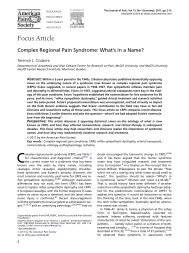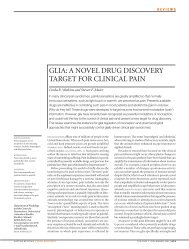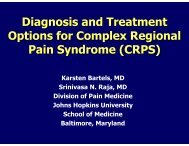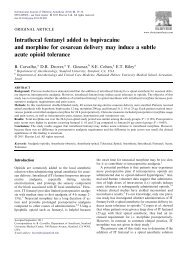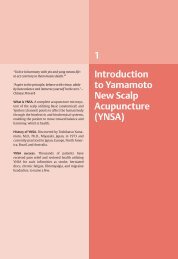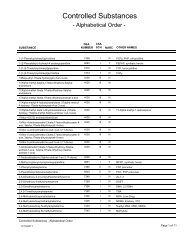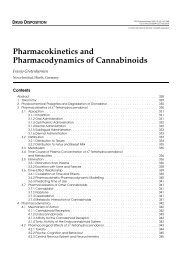1) Vitamin D For Chronic Pain - Pain Treatment Topics.org
1) Vitamin D For Chronic Pain - Pain Treatment Topics.org
1) Vitamin D For Chronic Pain - Pain Treatment Topics.org
Create successful ePaper yourself
Turn your PDF publications into a flip-book with our unique Google optimized e-Paper software.
<strong>Vitamin</strong> D for <strong>Chronic</strong> <strong>Pain</strong><br />
TABLE 5. <strong>Vitamin</strong> D Supplementation for<br />
<strong>Chronic</strong> <strong>Pain</strong><br />
PROPOSED CONSERVATIVE DOSING PROTOCOL<br />
• In patients with chronic, nonspecific musculoskeletal<br />
pain and fatigue syndromes, it usually can be expected<br />
that vitamin D intake from combined sources is inadequate<br />
and concentrations of serum 25(OH)D are insufficient<br />
or deficient.<br />
• All patients should take a multivitamin to ensure at least<br />
minimal daily values of essential nutrients, including<br />
calcium and 400 IU to 800 IU of vitamin D.<br />
• Recommend a daily 2000 IU vitamin D 3 supplement,<br />
bringing total supplement intake to 2400 to 2800 IU/day<br />
(incl. from multivitamin). Extra calcium may not be necessary<br />
unless diet is insufficient and/or there are concerns<br />
about osteoporosis (e.g., in postmenopausal<br />
women or the elderly).<br />
• Monitor patient compliance and results for up to 3<br />
months. Other therapies for pain already in progress do<br />
not necessarily need to be discontinued.<br />
• If results are still lacking after 3 months, or persistent<br />
25(OH)D deficiency or osteomalacia are verified, consider<br />
a brief course of prescribed high-dose vitamin D 3<br />
with, or without, added calcium as appropriate, followed<br />
by ongoing supplementation as maintenance.<br />
therapy to effectively raise 25(OH)D concentrations, lower PTH<br />
levels, and/or saturate vitamin D receptors with the 1,25(OH) 2 D<br />
metabolite. In some cases, the patient might benefit from a<br />
course of high-dose vitamin D 3 supplementation followed by<br />
more conservative doses for ongoing maintenance.<br />
There is always the possibility that a particular chronic pain<br />
condition cannot be alleviated by vitamin D 3 supplementation<br />
alone. <strong>For</strong> example, there may be a previously undetected<br />
anatomic defect, disease, or other pathology that would benefit<br />
from another type of therapeutic intervention in addition to<br />
vitamin D therapy.<br />
At the doses recommended in Table 5, excessive accumulation<br />
of 25(OH)D or toxicity over time would not be expected<br />
and this supplementation might be continued indefinitely. It<br />
must be noted, however, that clinical investigations have largely<br />
observed subjects during months rather than years of ongoing<br />
supplementation, and long-term effects of vitamin D therapy<br />
on functions at the cellular level are still under investigation. 30<br />
If there are concerns, after a year or longer the supplement<br />
might be continued at a reduced dose; it can always be increased<br />
again if pain symptoms return.<br />
How Long Until Improvement In anecdotal case reports,<br />
vitamin D supplementation provided complete relief within a<br />
week in some patients having widespread, nonspecific pain that<br />
was unresponsive to analgesics, including opioids. 79 In other<br />
cases, pain and muscle weakness reportedly resolved “within<br />
weeks” of beginning supplementation. 72<br />
In one study, pain relief from neuralgia was achieved at 3<br />
months after beginning vitamin D supplementation. 91 In many<br />
cases, bone-related pain may require approximately 3 months<br />
of adequate vitamin D supplementation for its relief, 47,65 while<br />
muscle pain may need 6 months, and muscle weakness or fatigue<br />
may require even longer to resolve. 47,65,76<br />
Overall, Vasquez and colleagues 37 recommended that at least<br />
5 to 9 months should be allowed for fully assessing either the<br />
benefits or ineffectiveness of vitamin D supplementation.<br />
Likewise, Vieth et al 100 suggested that the greatest physiologic<br />
responses may occur after 6 months of supplementation. Therefore,<br />
the timeframe recommended in Table 5 – monitoring<br />
results for up to 3 months – should be considered a minimum<br />
period of watchful waiting.<br />
Complete pain relief would be easy for patients to detect, but<br />
in most cases this could be an unrealistic expectation. The<br />
evidence is suggestive of a potential range of improvements with<br />
vitamin D therapy, some more obvious than others. <strong>For</strong> example,<br />
instead of complete pain relief, patients may experience partial<br />
relief, reduced intensity or frequency of pain, less soreness or<br />
stiffness in muscles, increased stamina or strength, reductions<br />
in NSAID or opioid use, and/or improvements in mood or<br />
overall quality of life. These results are less spectacular than<br />
complete pain relief, but are still important and worthwhile<br />
outcomes to monitor.<br />
<strong>Vitamin</strong> D Safety Considerations<br />
The highly favorable safety profile of vitamin D is evidenced by<br />
its lack of significant adverse effects, even at relatively high<br />
doses, and the absence of harmful interactions with other drugs.<br />
While vitamin D is potentially toxic, reports of associated<br />
overdoses and deaths have been relatively rare.<br />
Tolerance & Toxicity. Excessive intake and accumulation of<br />
vitamin D is sometimes referred to as “hypervitaminosis D,”<br />
however this is poorly defined. Because a primary role of vitamin<br />
D is facilitating absorption of calcium from the intestine, the<br />
main signs/symptoms of vitamin D toxicity result from excessive<br />
serum calcium, or hypercalcemia (see Table 6).<br />
The rather diverse signs/symptoms of hypercalcemia in<br />
patients with pain may be difficult to attribute to vitamin D<br />
intoxication, since they might mimic those of opioid side effects,<br />
neuropathy, or other conditions. Paradoxically, some symptoms<br />
match those of hypocalcemia. In some cases, patients with serum<br />
25(OH)D at toxic levels can be clinically asymptomatic. 126<br />
Since full exposure to sunlight can provide the vitamin D 3<br />
equivalent of up to 20,000 IU/day, the human body can obviously<br />
tolerate and safely manage relatively large daily doses. Toxicity<br />
has not been reported from repetitive daily exposure to sunlight. 25<br />
Still, supplementation via commercially manufactured<br />
vitamin D products would circumvent natural mechanisms in<br />
human skin that prevent excess D 3 production and accumulation<br />
resulting from sun exposure. A Tolerable Upper Intake<br />
Level, or UL, for oral vitamin D 3 supplementation—which is<br />
the long-term dose expected to pose no risk of observed adverse<br />
effects—currently is defined in the United States as 1000 IU/day<br />
in infants up to 12 months of age and 2000 IU/day for all other<br />
ages. 16 However, many experts assert that the 2000 IU/day UL<br />
is far too low. 19,35-37,39,42 An extensive review by Hathcock et al, 121<br />
applying risk-assessment techniques, concluded that the UL for<br />
vitamin D consumption by adults actually could be 10,000<br />
IU/day of D 3 , without risks of hypercalcemia.<br />
However, the duration of high vitamin D intake may be the<br />
34 Practical PAIN MANAGEMENT, July/August 2008<br />
©2008 PPM Communications, Inc. Reprinted with permission.



